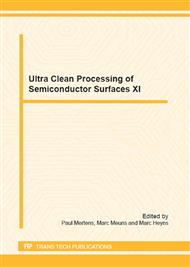p.107
p.110
p.114
p.119
p.124
p.128
p.132
p.136
p.139
Introduction of a Dynamic Corrosion Inhibitor for Copper Interconnect Cleaning
Abstract:
Copper has become the material of choice for the interconnects in semiconductor devices due to its low resistance and ease of processing [1]. Device fabrication with copper requires electrochemical deposition and chemical mechanical planarization (CMP). Since the polished copper surface generated during CMP is considered to be one of the most important factors which determine the performance of the interconnect, post-CMP cleaners must efficiently remove residues generated by the polishing process [2]. CMP slurries and post-CMP cleaners frequently include corrosion inhibitors to form a protecting layer on copper surface. If a thick organic film remains on copper after cleaning processes, it can have unfavorable effects on performance of copper interconnects. To minimize this issue, the authors earlier described a corrosion inhibitor which formed a very thin protective layer and that was easily removed by plasma treatment [3, 4].
Info:
Periodical:
Pages:
124-127
Citation:
Online since:
December 2012
Authors:
Keywords:
Price:
Сopyright:
© 2013 Trans Tech Publications Ltd. All Rights Reserved
Share:
Citation:


